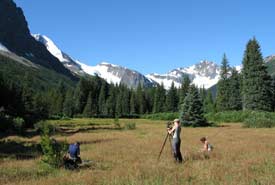The future of conservation is female (Part one)
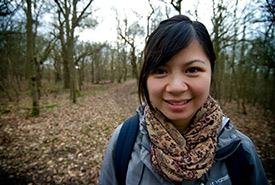
Jenna Siu (Photo by NCC)
In honour of International Women’s Day (March 8), over the course of the month we will be celebrating three young women who work for the Nature Conservancy of Canada’s (NCC’s) Ontario Region. We will speak with them to learn more about what led them to a career in conservation and recognize the important conservation work they do for their respective natural areas. We start today with Jenna Siu, conservation biology coordinator for Happy Valley Forest.
NCC: How did you get involved with nature conservation?
Jenna Siu (JS): I wasn’t always interested in nature. This interest came to me later than most of my peers who grew up camping at provincial parks and exploring the outdoors. My parents immigrated to Canada from Hong Kong. Nature wasn’t a big part of their upbringing, and so it wasn’t a part of mine. It wasn’t until university where I took a class about the diversity of life on Earth when something clicked for me. I started to realize just how much humans are a part of nature and how connected we are to other species and the landscape. I began to immerse myself in the field of ecology and conservation, gaining more research and field experience. After I completed my master’s and had a few contracts in the field, I had an opportunity to be an intern with NCC in Happy Valley Forest. That opportunity helped lead me to where I am now.
Related blog posts
NCC: Tell us about Happy Valley Forest.
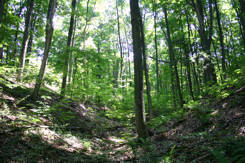
Upland forest in Happy Valley Forest, ON (Photo by NCC)
JS: Happy Valley Forest is about an hour north of Toronto, in King Township, on the Oak Ridges Moraine. It’s the largest tract of upland deciduous forest remaining on the moraine. NCC has helped protect nearly 800 acres (just over 300 hectares) of more or less continuous mature forests. Experts say we need a minimum of 500 acres (200 hectares) to support a healthy interior forest that is home to many deep woods species, like Acadian flycatcher, cerulean warbler and red-shouldered hawk, and we have well surpassed that minimum. One of our main goals in protecting Happy Valley Forest is to ensure that it will become an old-growth forest in the next 50 to 100 years.
NCC: Tell us about a particular species of interest in your natural area.
JS: One group of animals we’ve been monitoring in Happy Valley Forest is bats. There are eight species of bats in Ontario. Four of these have been listed as endangered since 2012 due to an introduced disease called white-nose syndrome, which affects cave-hibernating bats. This includes little brown myotis (formerly known as little brown bat), which was once considered the most common bat in Ontario and is now greatly threatened.
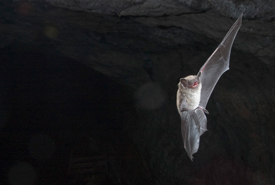
Little brown myotis (Photo by Brock Fenton)
In Ontario, we know relatively little about our bat populations. They are difficult to observe because they fly around at night and generally don’t make sounds that we can easily hear. Yet they are just as important to the ecosystem as some of their more visible counterparts, like birds. One thing that we do know about them is that mature forests are a key habitat for them, which makes Happy Valley Forest a great place to monitor them and an important place to protect.
NCC recently partnered with the Toronto Zoo to put up four acoustic detectors throughout Happy Valley Forest and Pottageville Swamp to the north, on NCC-owned lands, and lands of other willing landowners. These detectors record the bats’ high frequency echolocation calls each evening, from mid-April to the end of October. Our results show that six out of eight species of Ontario’s bats are present in the area, including plenty of activity from species at risk bats. This is really great news! This means that through this partnership we are helping to fill in some knowledge gaps about our Ontario bat populations, and that NCC’s work to steward and protect their habitat is particularly important in this area. Protecting places like Happy Valley Forest is a necessary part of their recovery.
NCC: As you look to the future what do you see?
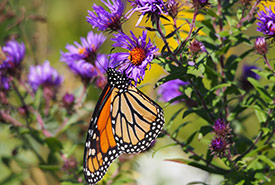
Monarch (Photo by Mary Gartshore)
JS: It’s hard not to think about the future without thinking about the next generation. We’ve hosted several guided hikes in Happy Valley Forest, and one hike that sticks out in particular is one where an eight-year-old boy and his family came. This young boy was excited about nature from the get-go. During the hike we watched a monarch butterfly flutter from milkweed to milkweed. We simply watched it; there was no desire to try and catch it or disrupt it in any way. After it flew away, I suggested we look at the leaves to see if it laid an egg. We didn’t find one, but the young boy hypothesized that maybe the plant was too small and the butterfly would want a bigger plant to feed its young. The jury may still be out on his hypothesis, but his curiosity, patience and creativity was impressive.
During my time at NCC, I’ve been involved with several outreach events for various ages. It’s always refreshing to see younger generations come with such interest and enthusiasm for nature. It gives me hope that if we do our part now in protecting these places, they will be in good hands in the future.

